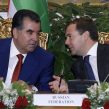
Russia Seeks to Boost Ties with Tajikistan
Publication: Eurasia Daily Monitor Volume: 6 Issue: 149
By:

Russian officials have reiterated their continued interest in deepening bilateral cooperation with Tajikistan, while the authorities in Dushanbe appeared to remain hesitant on some issues. On July 31 the Russian President, Dmitry Medvedev, traveled to Tajikistan, and used the opportunity to launch a major joint project. Medvedev and his Tajik counterpart, Emomali Rahmon, jointly inaugurated the Sangtuda-1 hydropower plant, which is due to generate some 12 percent of Tajikistan’s electricity output.
Russia has participated in the construction of the 670 mega watt Sangtuda-1 which started in April 2005, but the project has suffered numerous delays. Russian energy executives had pledged to launch the first unit of Sangtuda-1 in March 2007, but this was rescheduled until the end of 2007, and then March 2009. Repeated delays of the Sangtuda-1 project have been an irritant in bilateral economic relations. Nonetheless, the Kremlin reiterated interest in continued energy cooperation with Tajikistan. On July 31, Medvedev announced that both sides were drafting new energy agreements, but refrained from elaborating any further details (Interfax, RIA-Novosti, July 31).
In addition to Sangtuda-1, Moscow pledged to invest some $2 billion in the Rogun hydropower project. In August 2007, Tajikistan announced the decision to annul a cooperation agreement with Russia’s aluminum giant Rusal to build the $1.3 billion Rogun hydropower plant. Subsequently, the Russian government confirmed its interest in the Rogun project, yet little progress has been achieved so far.
Bilateral economic ties have experienced a revival in recent years. In 2008, trade between Russian and Tajikistan amounted to $1 billion or 30 percent up year-on-year, according to Russian statistics. However, in January-May 2009, bilateral commerce was 22 percent down year-on-year due to the adverse effects of the economic crisis (Interfax, RIA-Novosti, July 30). In recent years Moscow has been wary of Dushanbe’s perceived intention to restrict the use of the Russian language. The issue was apparently addressed at the latest bilateral summit. After the meeting, Medvedev’s aide Sergey Prihodko said that Russia had no concerns about the use of the Russian language in Tajikistan. Rahmon expressed his interest in the continued use of the Russian language, Prihodko said (Interfax, RIA-Novosti, July 31).
Moreover, in addition to energy and cultural considerations, Russia also has significant security interests in Tajikistan. In April 1999, Russia and Tajikistan signed a treaty on alliance and partnership. In June 2004, Russia agreed to write-off Tajikistan’s outstanding debt in exchange for the control over the Okno (Window) space surveillance complex and $50 million in Tajik investments in the Sangtuda-1 project. During Vladimir Putin’s visit to Dushanbe in October 2004, Russia formally took over the Okno complex. Located in the Tajik mountainous region near the border with China this has remained an important foreign-based installation for Russia. On July 31, Medvedev visited the Okno facility near Nurek and hailed the continued operation of the space surveillance complex (Interfax, RIA-Novosti, July 31).
Russia also maintains a strong military presence in Tajikistan. Russia had about 20,000 troops in the country comprised of the 201st Motor Rifle Division (MRD) and its Federal Security Service (FSB) border guards in Tajikistan. In October 2004, Russia secured the status of a permanent military base for the 201st MRD in Dushanbe. Moscow also secured a 49-year land lease deal for the space surveillance complex at Nurek at a symbolic $0.39 per year. From October 1, 2005, the 201st MRD was officially transformed into Russia’s 201st base in Tajikistan. Russia now maintains garrisons in Dushanbe, Kurgan-Tebe and Kulyab.
Security and economic issues dominated the agenda of the latest high level meetings. On February 24 Medvedev met Rahmon at his Zavidovo residence outside Moscow. Although no particular agreements were announced after this meeting, Rahmon was widely thought to want better terms on security and energy deals, as a type of compensation for loyalty. Moreover, Rahmon was believed to want more money for the use of the Russian military facilities in Tajikistan. On July 30, the Kommersant business daily speculated that Rahmon was keen to extract Russian payments for the 201st base deployment. As international prices of Tajikistan’s main exports, aluminum and cotton, remain low the Tajik authorities desperately need new cash inflows and require financial incentives from Russia, the daily wrote (Kommersant, July 30).
The issue of payment for the use of the Russian military facilities in Tajikistan was reportedly discussed at the latest bilateral summit. Medvedev and Rahmon ordered government officials to negotiate the terms and conditions for the 201st base, Prihodko announced. During their talks, both leaders did not discuss any details of bilateral military cooperation, he argued. (Interfax, RIA-Novosti, July 31). Therefore, no concrete agreements were concluded and consequently the issue will remain a matter for future bilateral negotiation.
Meanwhile, Moscow reiterated that its policy in Central Asia has a strong international dimension. On July 30, Medvedev attended a summit meeting with the leaders of Afghanistan, Pakistan and Tajikistan, and hailed it as a "new form of dialogue," aimed at boosting regional security, and maximizing Russian influence (Interfax, RIA-Novosti, July 30).




